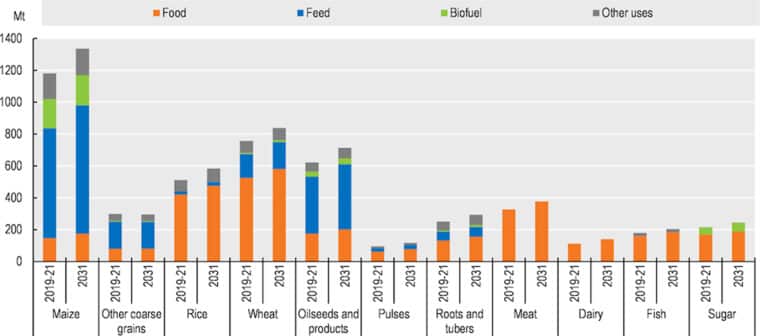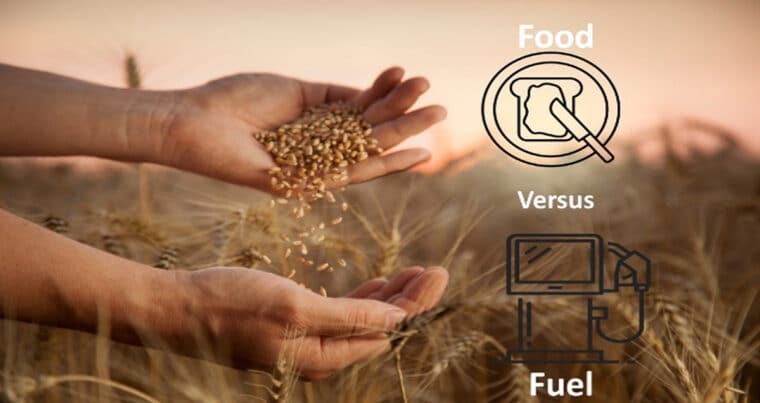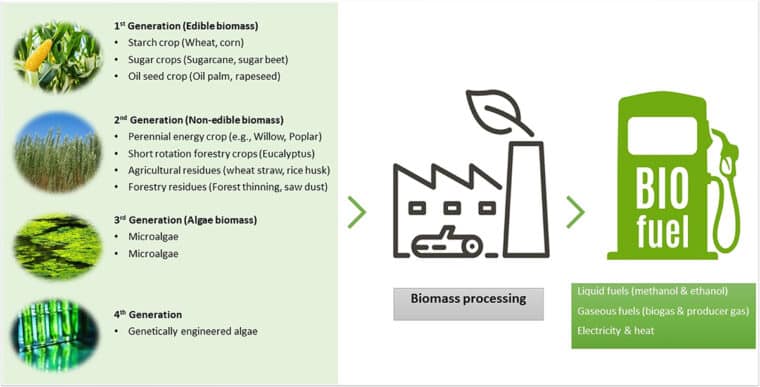Does production of biofuel mean less food production?
Take home messages:
- The food versus fuel debate calls into question the ethics of diverting land from food to biofuel production.
- Bioenergy production from first generation (edible) biofuel feedstock may compete with food production and as consequence affect food security.
- A shift towards increasing production of second generation (non-edible) biofuel feedstocks and third generation biofuels along with advanced technologies of genetically engineered algae biomass would avoid the competition for food.
- Food and bioenergy need not compete for land. Biofuel crops should be integrated into existing landscape and agricultural lands in a multifunctional approach to improve use as food, fuel and for other ecosystem services.
Introduction
Biofuels have the potential to reduce reliance on fossil fuels whiles reducing environmental impacts and greenhouse gas emissions. Biofuel makes a small contribution to our energy demand whiles fossil fuels contributing approximately 87 percent of energy having a negative impact of increase in global warming. To limit global warming, biofuel production should be increased from 9.7 × 106 GJ d−1 to 4.6 × 107 GJ d−1 between 2016 and 2040. This would require large scale deployment of biofuel feedstock production and advanced technologies in biofuel production. However, there are trade-offs related to the expansion of bioenergy feedstock production by diverting land use from food to biofuel production, which poses a threat to food security especially in developing countries, and directly or indirectly leading to deforestation and other changes of land use that have a negative effect on greenhouse gas emissions. This calls into question the ethics of diverting land from food to energy and whether it implies less food production. In this article, we provide a review of the food versus fuel debate, whether a shift to other alternative biofuel feedstocks would avoid this competition for food.
Food versus fuel debate
The food versus fuel debate calls into question the ethics of diverting land from food to energy production. The opinion piece written by the Guardian columnist, George Monbiot in 2004, brought attention to the issue of devoting land to fuel production in his article entitled ‘Feeding cars, not people’. He argued that the expansion of biofuel production is at the expense of food which is much needed to feed a growing population especially the food insecure in developing countries. A wide range of perspectives on the debate of food versus fuel further emerged following increases in world crop prices for cereals and vegetable oils which are raw materials for producing biofuels. Biofuels are produced from the fermentation of biological feedstocks containing fermentable sugars, lipids, or carbohydrates. Biofuels are categorized into first, second, third and fourth generation biomass feedstocks (see figure 1).
What are the implications of use of first generation feedstocks for biofuels?
First generation biofuel feedstocks have been at the centre of the food versus fuel debate. First generation biofuels are produced from easily accessible and edible fractions of food crops. They produce large amounts of lipids or carbohydrates that are easily converted into biofuels. Bioethanol is produced from sugar crops (e.g., sugarcane, sugar beet and sweet sorghum) and starch crops (e.g., wheat, maize, and cassava), while oil seed crops such as rapeseed, sunflower, oil palm, and soybean may be used for production of biodiesel. These edible feedstocks have been mainly used for producing biofuels globally and have been highly commercialised, contributing over 50 billion litres of the total fuels produced per year. However, there are trade-offs with producing such edible feedstocks for biofuel production.
First, increasing production of first generation biofuel feedstock impacts food security, due to competition for direct land use. Thus, any dedicated use of productive land for production of biofuel feedstock inherently comes at a cost of not using the land for food or feed production. This claim is however based on the assumption that land is a limiting factor for global food production and to meet the rising demand for food and fuel will require newly cleared land leading to deforestation and increases in greenhouse gas (GHG) emissions. On the other hand, others have argued that global land is not a limiting factor when land cover, land use, and productive potential are considered.
Another facet to the debate is that the demand for biofuels has an impact on food prices, which disproportionately affect poor people in the global south who spend roughly half of their household incomes on food. The increased demand for production of biofuels from food grains and oilseeds in the U.S. and the EU contributed to this increase in food price, much of which was due to policies that incentivised production of biofuels. On the other hand, some studies have shown that biofuel prices do not seem to affect food commodity prices and have not been the most important contributing factor for food price inflation and that, different biofuels have different impacts on prices of food commodities. Such studies have found no strong evidence that biofuels such as ethanol would drive food commodity price.
Furthermore, there is evidence that these biomass feedstocks may not have a direct impact on food production since they are grown for different purposes. For instance, from the data on global use of major food commodities (see figure 2), the volume of use of maize, a major biofuel feedstock is mostly used for animal feed. The OECD-FAO projections on global use of maize is largely more towards animal feed production. Thus, the type of biomass production may not have a direct impact on food production since they are grown and used for different purposes. Hence, there is the need to examine the interdependencies between the multiple end-uses of biofuel feedstocks.

Figure 2: Global use of major commodities
Lastly, the studies have shown that first generation biofuels are poor crops for biodiversity and compete for water resources. For example, production of maize presents the risk of soil erosion, soil damage and runoff water which affects soil health. Limits should be set on bioenergy support schemes to regulate or control the amount of food and feed crops that can be used for production of biofuels.
Would second generation biomass crops avoid the competition for food?
In view of the negative trade-offs of first generation biofuel crops, second generation biofuel feedstocks which are derived from non-edible biomass have been proposed as more suitable for production of biofuels, as these feedstocks do not compete with food production. Second generation biofuels are based on lignocellulosic feedstocks including perennial energy crops (e.g., Miscanthus, short rotation coppice willow, poplar), Short rotation forestry (e.g., eucalyptus, black locust, paulownia), agricultural residues (e.g., forest thinning, sawdust, sugarcane bagasse, rice husk, rice bran, corn stover, wheat straw, and wheat bran), and forestry residues (e.g., small branches and bark from forest thinning operations, conservation management operations, wood pellets, or wastes from wood processing industries such as sawdust).
Compared to first generation biofuel feedstock, these non-edible feedstocks do not compete for food, can grow on marginal land, do not require much input such as fertilizers, and provide additional ecosystem benefits such as increasing biodiversity and soil carbon and reducing greenhouse gas emissions. They produce high amounts of biomass and can be harvested regularly over a long period and be processed for use as biofuels. These biomass crops have a potential to play a key role in decarbonisation of economies, both as a substitute to fossil fuel energy reducing greenhouse gas emissions, as well as to generate negative emissions using carbon capture and storage (BECCS).
However, the competition for land and food may still persist if productive land for food production is used for growing second generation biomass feedstocks. Planting second generation biomass feedstocks on marginal land avoids the competition for land use and food. Also, bioenergy crops should be integrated into existing landscape and agricultural land in a multifunctional approach to offer multiple benefits including use as fuel and other ecosystem services.
Shifting to third generation bioenergy feedstock and more advanced technologies?
Third and fourth generation biofuels are more promising as they do not create such land use and food competition. Third generation biofuels are non-food marine biomass derived from algae including, seaweeds (green, red, and brown macroalgal species) and microalgae. These algae biomass have higher growth rates and do not require an arable or big land area for production and hence do not compete with land for food and also act as carbon sink.
With advanced technologies of genetic modification of microalgae, fourth generation biofuels are seen as more promising sustainable biofuel feedstock due to their high biofuel productivity and ability to capture large amounts of carbon dioxide. Research is still advancing in the use of genetically modified algae. As these technologies become more advanced, efficient, and economical, they could replace uses of first generation biofuels and fossil fuels for sustainable energy production.
Sustainable biofuel production in the UK
In the UK, bioenergy plays an important role in decarbonising the energy system by reducing greenhouse gas (GHG) emissions, expanding renewable energy and moving towards a low-carbon economy. Domestic biofuel crop production however constitutes a small component of existing agricultural land. Less than 1.4 percent of 18.6 million ha of agricultural land in the UK is currently used for bioenergy crops. In 2020, 121,000 ha of agricultural land were used to grow bioenergy crops. Of this, 92 percent constituted edible food crops for biofuels (diesel and bioethanol) and biogas, and about 8 percent constituted non-food biofuels used for electricity and heat generation. Future projections to reach net zero ambitions estimates planting about 30,000 ha yearly through to 2035 and estimated cultivation of 70,000 ha of bioenergy crops by 2050. This will certainly require large scale expansion of land for biofuel feedstock production.
A shift towards increasing production of second generation (non-edible) biofuel feedstocks and third generation biofuels along with advanced technologies of genetically engineered algae biomass would avoid the competition for food. The second generation biofuel crops may not necessarily compete directly with food production if grown on marginal lands including under-used, inaccessible, inconvenient, land prone to flooding, or degraded land. It is estimated that 1.4 million hectares of marginal land in the UK could potentially be planted with perennial energy crops by 2050 avoiding competition for arable land for food production. Planting should also be prioritised on low quality agricultural lands (Grade 5‐4‐3b), public access land, contaminated land and land identified by the Forestry Commission as low risk for woodland creation. However, planting should be avoided on UK Biodiversity Action Plan (BAP) priority habitats, land with cultural value, peatlands and other high carbon soils >120 t C ha‐1.
Food and bioenergy need not compete for land and, instead, should be integrated to improve resource management. Bioenergy crops should be incorporated into existing landscape and agricultural land in a multifunctional approach to deliver multiple outputs from the land including food, biodiversity, climate change, waste absorption, and other societal purposes.
Conclusion
The dilemma of diverting land from food to energy production has made bioenergy crops controversial with wide range of perspectives. Biofuels produced from using edible biomass stocks have been at the centre of the food versus fuel debate, with serious criticism that it may lead to competition with food, increase food prices, deforestation and other changes of land use that have a negative effect on greenhouse gas emissions. A shift towards increasing production of second generation (non-edible) biofuel feedstocks and third generation biofuels along with advanced technologies of genetically engineered algae biomass would avoid the competition for food. Planting second generation biomass feedstocks on marginal land avoids the competition for food production. Food and bioenergy need not compete for land, instead, biofuel crops should be integrated into existing landscape and agricultural lands in a multifunctional approach to offer multiple benefits including use as fuel and for other ecosystem services.





